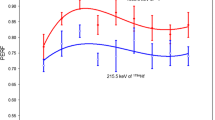Abstract
A straightforward method for demonstrating the powerful background reduction of Compton suppression spectrometers for neutron activation purposes is presented. The shorter acquisition time needed in Anti-Compton mode (A/C on) for peaks of appropriate counting statistics, compared to normal gamma counting (A/C off), allows a much higher sample throughput, thus compensating for the higher cost of the instrument. Two examples of artificial mixtures of radio- nuclides demonstrate the drastic time saving for measurement of monoenergetic decaying isotopes. The comparison of results from three different instruments proves the general usefulness of Compton suppression spectrometers for Neutron Activation Analysis of biological samples.
Author to whom all correspondence and reprint requests should be addressed.
Access this chapter
Tax calculation will be finalised at checkout
Purchases are for personal use only
Preview
Unable to display preview. Download preview PDF.
Similar content being viewed by others
References
J. A, Cooper and R. W. Perkins, Nucl. Inst. Meth. 99, 125–146 (1972).
J. op de Beeck, A. Isebaert, and J. Hoste, J. Radioanal Chem. 76, 225–239 (1983).
J. A. Cooper, Nucl. Inst. Meth. 82, 273 (1970).
U. Rösick and P. Brätter, Z, Anal Chem. 286, 336–342 (1977).
H. S. Das, J. Radioanal Nucl. Chem. 115, 159–173 (1987).
M. Rossbach and M. Stoeppler, J. Radioanal Nucl. Chem. 113, 217–223 (1987).
H. R. Vogt and R. Zeisler, Internation Conference on Nuclear Analytical Methods in the Life Sciences, Gaithersburg, MD, 1989, p. 154.
Author information
Authors and Affiliations
Editor information
Editors and Affiliations
Rights and permissions
Copyright information
© 1990 Springer Science+Business Media New York
About this chapter
Cite this chapter
Rossbach, M., Zeisler, R., Woittiez, J.R.W. (1990). The Use of Compton Suppression Spectrometers for Trace Element Studies in Biological Materials. In: Zeisler, R., Guinn, V.P. (eds) Nuclear Analytical Methods in the Life Sciences. Humana Press, Totowa, NJ. https://doi.org/10.1007/978-1-4612-0473-2_8
Download citation
DOI: https://doi.org/10.1007/978-1-4612-0473-2_8
Publisher Name: Humana Press, Totowa, NJ
Print ISBN: 978-1-4612-6777-5
Online ISBN: 978-1-4612-0473-2
eBook Packages: Springer Book Archive




